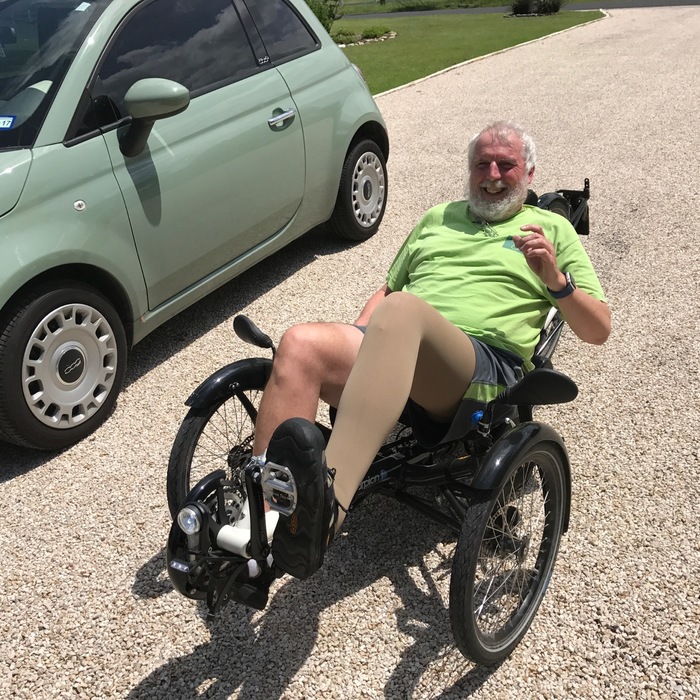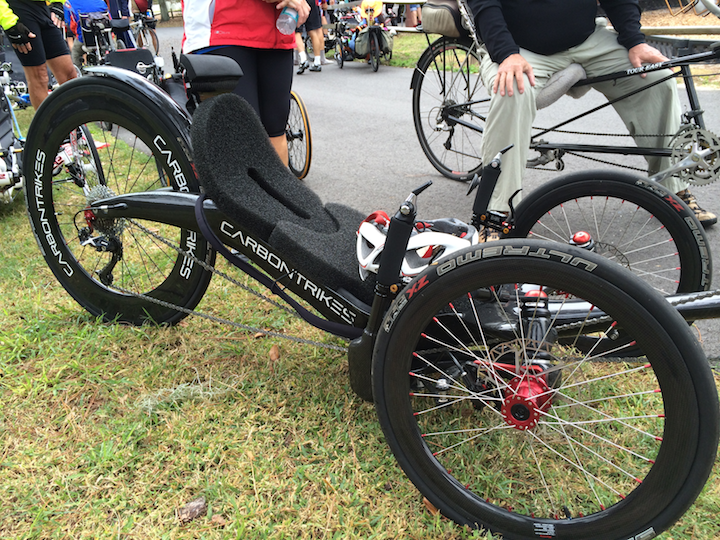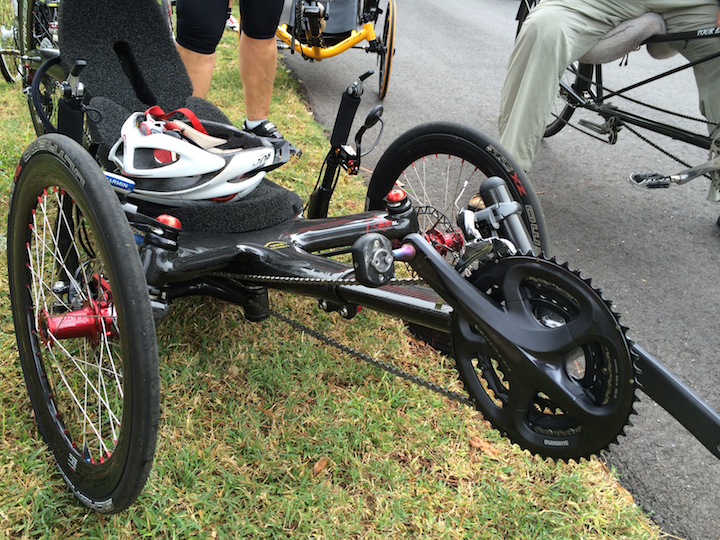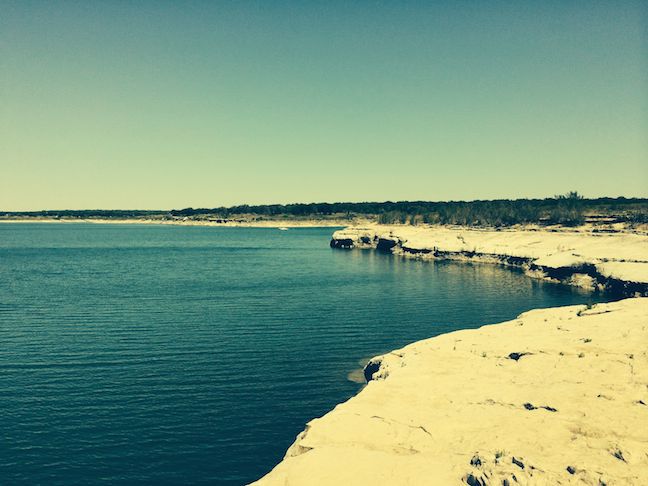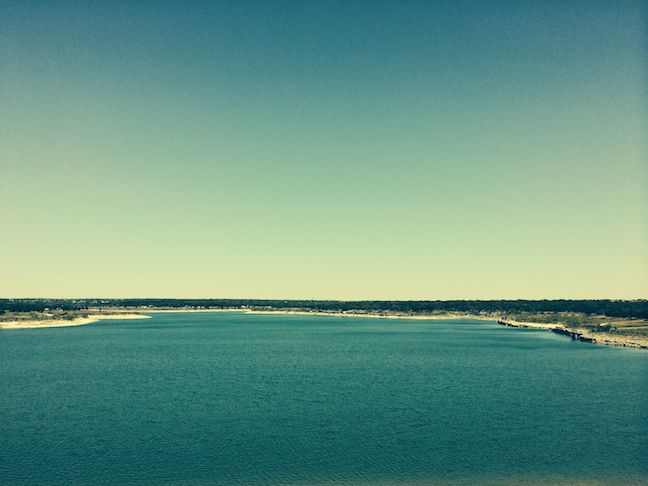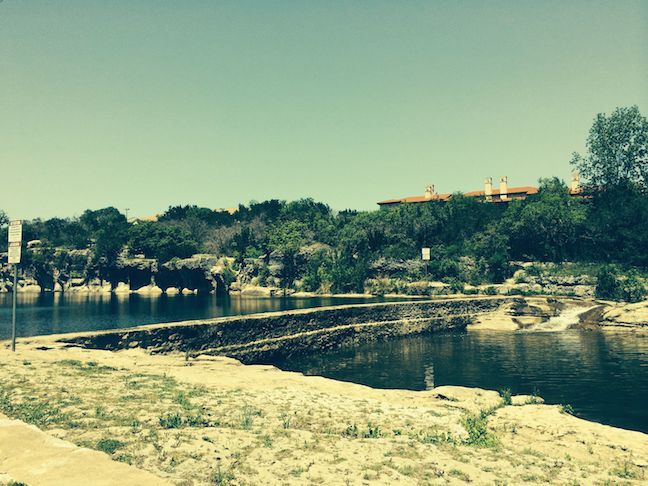Three and 1/2 years ago (August 2010) I walked into Easy Street Recumbents and purchased my first trike - a Catrike Expedition.
I had not ridden a bicycle in many, many years and was just told by my doctor I was technically morbidly obese. Additionally, my knee doctor was recommending knee replacement and said that the only exercise I was allowed to do was easy bicycle riding and swimming. This was at age 52 and was definitely my wake up call for fixing my health issues.
I rode the trike for about 2,750 miles over then next several months and little by little lost 45 pounds. I started out being able to ride just about 5 minutes before being extremely out of breath and just kept after it to where now a few years later I’m a pretty decent front of the pack rider (top 10 percent).
People consider my story a success story and I get many questions of others in similar circumstances. Following are several questions I received from a friend of mine that are representative of just starting out in recumbents. I’m answering them here so that I can find it later when I get asked again.
1. How do we push to get better? Heartrate? Distance without stopping? Speed?
When starting out on a trike, and you are very over weight as I was, the main concern is your health. Get the ok from your doctor to exercise, the type of exercise and how to monitor your exercise.
That being said - when I started out I immediately purchased a heart rate monitor and watched it very carefully during my first few months of riding. I really recommend one becomes familiar with their heart rate zones and understanding their effect on the body.
My main concerns were keeping my heart rate reasonable and maximizing my calories per unit time on bike. Everyone is different but for me at the time my target heart rate was over 120 beats per minute (bpm) and under 130 bpm. In my condition at the time my legs were not very strong and it was difficult to get my heart rate up over 120. Also, because I was so out of shape once over 120 bpm my rate would quickly zoom up past 150 if I was not very careful.
Over time as my leg muscles improved, and my breathing capacity improved, it became easier to keep my heart rate in the target zone.
2. How should Susie use her electric assist? (she is able to outpace me all the time if she wants to) This question is because she wants to use less assist over time, but we don’t know how to pace the assist.
I do not have direct experience with this, but here is my recommendation.
The rides should be about enjoyment.
Susie should peddle until she becomes tired and needs a break. She should then use the electric assist to keep up with you. You should slow down and peddle slower with her when she is peddling (ie then you are resting). When she gets tired and starts using the assist is the time when you should peddle faster and really put some effort into it. Watch your heart rate though. Susie should try to ride slower with the electric assist so that she matches your speed.
3. If we ride for 8 or so miles, then stop for coffee, or a break for 15 minutes, have we reduced our training?
No. The big killer of training is not riding at all. Riding to a destination and then stopping and smelling the roses really helps with the motivation and keeps the training active. Because of my banged up leg for the last couple of weeks Robyn and I have been riding to lunch on the trikes. About 12 to 14 miles total and a really enjoyable way to exercise. Keep up the riding. You are very fortunate to have close destination for coffee.
4. I can’t seem to maintain a cadence for long periods. I get tired, so at every down slope, I coast, and then push to get back to speed and catch Susie. Susie seems to keep on cranking at 70 or so. We both are fairly good at keeping our cadence around 70, but my I get tired quickly.
This sounds about right. Cadence takes a long time to develop. I would not worry about cadence until your ride time get over two hours - that is when a high cadence helps - when the ride time is over 2 hours. You can read about the technicalities of cadence conditioning here: http://danhansenjr.com/education/2013/08/17/slow-twitch-description.html
5. When I push to gain speed or go up a big hill, I have a tendency to stop breathing normally, instead I push without breathing, then gasp for breath, push some more, and repeat. If I don’t push, I either can’t speed up, or I go up hills VERY slowly, in a very slow gear.
Welcome to my world.
There are really two questions here: 1) what is correct breathing technique, and 2) how to get faster.
Learn to breath through you mouth - you can get more air in quicker than through your nose. Time your breathing with your cadence for a while. That is, make sure you breath in during two, or three, peddle revolutions, and then breath out for the same number of revolutions. I doesn’t really matter if the number of revolutions is 2,3,4, etc. as long as you are concentrating on the coordination of breathing and peddle stroke. After several days of this it will become normal and you will not forget about breathing while peddling.
Getting faster just takes time. I remember there were several hills around here were I live that I used to ride up them for 20 to 30 yards then just pull over and stop until my heart rate when down to a reasonable level.
The initial goal should be to just get up the hill no matter how long it takes. Once your legs start getting stronger you can ‘attack’ the hill and be almost completely wore out at the top. Use the following downhill to recover and try to be in an enough rested condition to attack the next hill. Unfortunately the only way to get better at hills is to ride lots of hills.
6. We both shift to maintain cadence at 70. Gone are the days of using the small and large front sprockets, except for steep hills for the small sprocket. So basically we have 10 speed trikes. Is this normal?
Yep - that is normal.
On all my trike/bikes I am basically in the front middle ring for the vast majority of the ride. I shift to the smaller front ring when on a really steep hill and I’m just barely moving up the hill (2 to 5 mph) - I could probably walk faster up some of those hills. I shift to the big ring when on a steep downhill had I have run out of gearing on the middle ring (usually around 25 mph).
I figure that on a typical ride I’m in the small front ring under 2 percent of the time and in the big ring maybe 5 percent of the time. When you need the little front ring, YOU REALLY NEED THE LITTLE FRONT RING. Sometimes instead of using the big ring I just coast and relax and enjoy the ride.
7. We are afraid of traveling on country roads. Is this just us, or with good lighting and flags, we should be able to travel roads? Cars go 70 mph, and there is a 6” paved shoulder, so we stick out into the lane by 25”. Any Ideas?
I will say this is the scariest part of riding a trike (or bike). And the bicycle forums are all over the map on this issue.
I now have a little over 10,000 (yes ten thousand) miles on back roads around Georgetown Texas and I’ll give you my thoughts and experiences.
Below is the strava heat map of roads I have ridden around my area. Light blue is least ridden, then darker blue, darker heavier blue, and then red for most ridden.
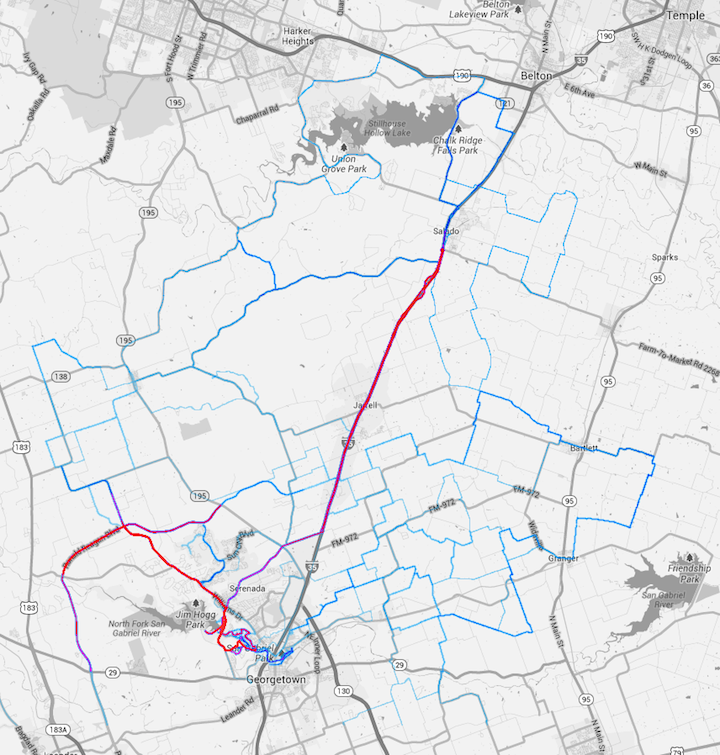
Remember these are my personal thoughts, opinions and actually experiences on Texas roads.
Flags are little more than worthless. They give you a false sense of security. I never noticed a difference in car driver patterns with, or without, the flag on the bike after thousands of miles.
Get the brightest flashing tail light you can afford. I now own three of these DiNotte tail lights:
 http://www.dinottelighting.com/LED_bike_lights/300r-red-taillight-with-built-in-battery.htm
http://www.dinottelighting.com/LED_bike_lights/300r-red-taillight-with-built-in-battery.htm
They are VERY expensive ($189 each). BUT - during the brightest summer day a driver coming up behind you will see them over a mile way. Drivers actually started moving over into the other lane once I put one of these on my trike. I now don’t ride without them on the roads. I’ve tried other rear flashing lights. They are all worthless except for the DiNotte.
The DiNotte have several flashing modes. Put the light on the ‘continuous on with intermittent flashing’ mode. That is the one drivers pay attention to the best.
During the day drivers usually see and avoid small animals in the road. They will see and avoid your trike. With the DiNotte lights, the vast majority of the time, they will completely move over into the other lane.
The one section of road that I am still really cautious of now is a tight right hand bend in the road where a field of high vegetation (corn, wheat, etc) hides the view of the trike such that a driver only has maybe a 50 to 60 yards distance to see and avoid me. In this case I really hung the side of the road, watch the mirror very closely and am prepared to bail into the weeds if necessary. This tight right hand bend scenario does not happen much around here - but I still pay attention to it.
8. How do we warm up before/during a ride? Susie stretches before, I don’t. My knees hurt for the first mile, then feel fine, my muscles burn for the first couple of miles, then feel fine. The soles of my feet hurt after 10 miles, but pulling or pointing my feet makes it better, and then it too goes away. (we are very interested in enjoying triking, but not so interested in the pain!)
I don’t warm up. Just make sure to take it really easy for the first 15 to 20 minutes. Your muscles do need to become accustomed to the exercise before really putting the strain to them.
Update
Based upon Shelly’s comments below I’m augmenting this section.
Your muscles absolutely do need to warm up and perform range of motion before serious exercising. Warming up on the bike does not stretch your muscles to the range of motion to prevent injuries later in your bicycling career.
My problem is I like riding more than stretching.
I will put together a short (less than 5 minute) stretching routine over the next couple of weeks and post it on this blog.
9. What is an obtainable goal for triking? My goal for the summer has been 20 miles in 2 hours. (we are far from this, but we are just starting). If we have no goal, other than keep cadence at 70, enjoy our time together, and simply spend time triking, is that enough, and to heck with my original idea of a goal?
Ten miles per hour for two hours in a row seems very aggressive for your first summer of triking.
My goals initially were to keep my heart rate above 120 for at least a 50 minute duration on the ride. This usually meant a ride of at least an hour and a half. The first 20 minutes warming up, then the next 50 minutes trying to keep my heart rate over 120, and then a 10 to 20 minute cool down. I did this for several months. On weekends I would ride longer at an easier pace.
The speed will come by itself later as your legs get stronger and you lose weight.
